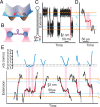Observing the base-by-base search for native structure along transition paths during the folding of single nucleic acid hairpins
- PMID: 34853166
- PMCID: PMC8670488
- DOI: 10.1073/pnas.2101006118
Observing the base-by-base search for native structure along transition paths during the folding of single nucleic acid hairpins
Abstract
Biomolecular folding involves searching among myriad possibilities for the native conformation, but the elementary steps expected from theory for this search have never been detected directly. We probed the dynamics of folding at high resolution using optical tweezers, measuring individual trajectories as nucleic acid hairpins passed through the high-energy transition states that dominate kinetics and define folding mechanisms. We observed brief but ubiquitous pauses in the transition states, with a dwell time distribution that matched microscopic theories of folding quantitatively. The sequence dependence suggested that pauses were dominated by microbarriers from nonnative conformations during the search by each nucleotide residue for the native base-pairing conformation. Furthermore, the pauses were position dependent, revealing subtle local variations in energy-landscape roughness and allowing the diffusion coefficient describing the microscopic dynamics within the barrier to be found without reconstructing the shape of the energy landscape. These results show how high-resolution measurements can elucidate key microscopic events during folding to test fundamental theories of folding.
Keywords: diffusion; folding; kinetics; optical tweezers; transition states.
Conflict of interest statement
The authors declare no competing interest.
Figures




Similar articles
-
Direct measurement of sequence-dependent transition path times and conformational diffusion in DNA duplex formation.Proc Natl Acad Sci U S A. 2017 Feb 7;114(6):1329-1334. doi: 10.1073/pnas.1611602114. Epub 2017 Jan 23. Proc Natl Acad Sci U S A. 2017. PMID: 28115714 Free PMC article.
-
Measuring the average shape of transition paths during the folding of a single biological molecule.Proc Natl Acad Sci U S A. 2019 Apr 23;116(17):8125-8130. doi: 10.1073/pnas.1816602116. Epub 2019 Apr 5. Proc Natl Acad Sci U S A. 2019. PMID: 30952784 Free PMC article.
-
Direct measurement of the full, sequence-dependent folding landscape of a nucleic acid.Science. 2006 Nov 10;314(5801):1001-4. doi: 10.1126/science.1133601. Science. 2006. PMID: 17095702 Free PMC article.
-
Probing microscopic conformational dynamics in folding reactions by measuring transition paths.Curr Opin Chem Biol. 2019 Dec;53:68-74. doi: 10.1016/j.cbpa.2019.07.006. Epub 2019 Aug 31. Curr Opin Chem Biol. 2019. PMID: 31479831 Review.
-
Structures, kinetics, thermodynamics, and biological functions of RNA hairpins.Annu Rev Phys Chem. 2008;59:79-103. doi: 10.1146/annurev.physchem.59.032607.093743. Annu Rev Phys Chem. 2008. PMID: 17937599 Review.
Cited by
-
Kinetics and dynamics of oligonucleotide hybridization.Nat Rev Chem. 2025 May;9(5):305-327. doi: 10.1038/s41570-025-00704-8. Epub 2025 Apr 11. Nat Rev Chem. 2025. PMID: 40217001 Review.
-
Nonlinear effects in optical trapping of titanium dioxide and diamond nanoparticles.Biophys J. 2023 Sep 5;122(17):3439-3446. doi: 10.1016/j.bpj.2023.07.018. Epub 2023 Jul 26. Biophys J. 2023. PMID: 37496270 Free PMC article.
References
-
- Bryngelson J. D., Wolynes P. G., Intermediates and barrier crossing in a random energy model (with applications to protein folding). J. Phys. Chem. 93, 6902–6915 (1989).
-
- Buchner J., Kiefhaber T., Protein Folding Handbook (Wiley-VCH, Weinheim, 2005).
-
- Hoffer N. Q., Woodside M. T., Probing microscopic conformational dynamics in folding reactions by measuring transition paths. Curr. Opin. Chem. Biol. 53, 68–74 (2019). - PubMed
Publication types
MeSH terms
Substances
Associated data
LinkOut - more resources
Full Text Sources

